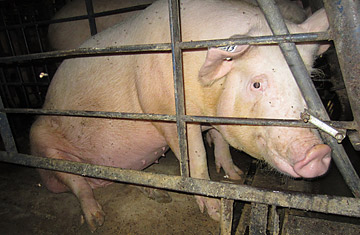

Pigs are intelligent animals that can be handled easily when proper training and techniques are put to use. Incorrect handling and a loud voice can cause pigs stress, so they should always be handled in a calm, quiet manner. Handling pigs is not the easiest thing to do, but the more you do it, the easier it becomes.
Getting to know your pigs
It helps if your pigs know and trust you, and are used to you touching and moving among them. Get into a routine of spending time with your pigs, rubbing them frequently all over their bodies (especially their ears, which they love to have rubbed) and talking to them. Pigs are intelligent and will often come running when they hear your voice, so by talking to them and using their names (if they have them), you are helping to build up a relationship with them that goes a long way towards stress-free handling.
Spend a few minutes each day moving them around in the pen, so that they learn what is required of them and you are safe in the knowledge that they cannot escape. Whenever you do have to move them from familiar situations, do so quietly and try not to make any sudden movements. Pigs that are kept quiet and stress-free will be far easier to move than worried or frightened pigs. When stressed, pigs become excitable, so never lose your temper if they won’t go in the direction you want. If you are having real problems, go and get help, or put them back and try again later when you have all calmed down. Bear in mind that pigs with lop ears tend to be quieter but more stubborn to handle than pigs with prick ears such as the Tamworth.
Pigs love a good scratch and often go all submissive if you touch the right spot. If they are breeding pigs, get them used to having their stomachs scratched, more often than not, they will roll over and lie down, which helps if you need to encourage the piglets onto the sow.
Moving pigs is much easier if you can teach them to follow a feed bucket, so if it is worth waiting until they are hungry if you need to move them. Pigs will follow buckets of food anywhere, but tread carefully when moving them in this way, as they could move that little bit faster than you and knock you over.
If your pigs are in an enclosure with an electric fence across the gateway, they will probably refuse to come out through the gate, even if you take the electric fence away, so always put a pile of straw across the gateway, as this seems to give them reassurance that they won’t get a shock.
Moving piglets
Moving very young piglets is usually not a problem. They will squeal, but they’re much more manageable than older piglets and less likely to wriggle. If you do need to move young piglets, carry out the procedure as quickly and quietly as possible, to keep the sow from becoming agitated.
Once piglets are a few weeks old and have started exploring outside their house, moving them can be even more difficult than moving adult pigs. Although they are smaller, so can be picked up and carried, catching them is an art in itself. They are nippier and more slippery than adult pigs, so do not try to catch them in the open, it just won’t happen.
If the piglets are in an ark or barn, corner one with a slapboard if necessary, grab it with both hands, placing your hands on either side of its body, and then lift it. If you’re not confident about catching piglets, put some food down and wait until their heads are in the trough before attempting to lift them. However, this only works for the first two or three piglets, after which they will be on their guard and will eat with one eye on you.
Try not to be put off by piglets’ squealing, which can be quite shocking when heard for the first time. And don’t pick them up by grabbing one leg – this risks straining the hocks or pulling joints out of place. Depending on the size of the piglets, some people put them in a large bucket or basket to carry them. This usually has the desired effect of stopping the squealing, but be careful they don’t jump out.
Moving adult pigs
The secret of moving pigs successfully lies in the preparation. Just because your pig is a quiet, well-behaved sow, that doesn’t mean you can just go into the pen, get her out and expect her to walk across two open fields without any problems. Always expect the unexpected, no matter how experienced you are or how many times you have moved pigs before.
If you are moving your pig from one enclosure to another near by, you need to have at the very least a slapboard, a stick and, for emergencies, that bucket of food. Ideally a temporary fenced walkway using portable gates should be constructed for a trouble-free walk between pens, but make sure it cannot be pushed down by a pig intent on escaping. Check that any gates leading to a road are firmly shut, so that if a pig does escape, it is contained within your property. It is possible to move a few pigs a fair way without using a trailer, but it is certainly not a one-person job. If you are walking them, get enough help to minimize potential problems, far better to have too much help than too little. And don’t hurry the pigs along. In hot season, try to move pigs early in the morning or in the evening when it is cooler.
 Contact Jaguza Support
Contact Jaguza Support